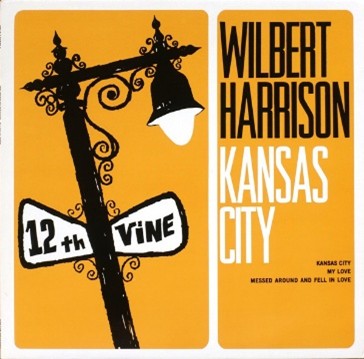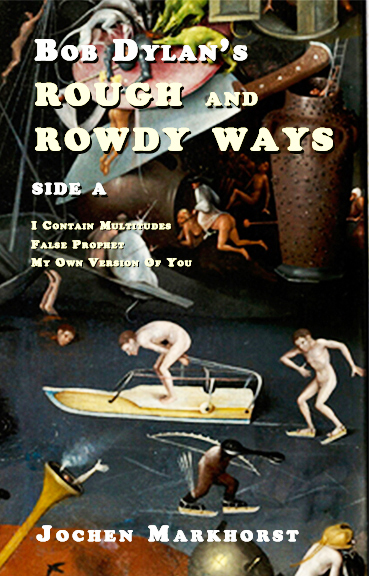Sitting on a Barbed Wire Fence Part 1
by Jochen Markhorst
II Kansas City, here I come
See my hound dog bite a rabbit And my football’s sittin’ on a barbed-wire fence
 On this first recording day for Highway 61 Revisited, 15 June 1965, producer Tom Wilson and Dylan have three hours, from half past two to half past five, at their disposal in Studio A. Roughly the first hour is spent on “It Takes A Lot To Laugh, It Takes A Train To Cry” (back then still called “Phantom Engineer Cloudy”), the last hour to the first attempts to unlock the cosmic power of “Like A Rolling Stone” (then still played at waltz tempo), and the hour in between is for “Sitting On A Barbed-Wire Fence”.
On this first recording day for Highway 61 Revisited, 15 June 1965, producer Tom Wilson and Dylan have three hours, from half past two to half past five, at their disposal in Studio A. Roughly the first hour is spent on “It Takes A Lot To Laugh, It Takes A Train To Cry” (back then still called “Phantom Engineer Cloudy”), the last hour to the first attempts to unlock the cosmic power of “Like A Rolling Stone” (then still played at waltz tempo), and the hour in between is for “Sitting On A Barbed-Wire Fence”.
Today, the song is registered on the recording sheet as “Over The Cliffs pt 1” and “Over The Cliff” respectively, which is a bit intriguing. It seems well thought out, in any case. “Over the cliff” does not have the nonsensical overtones of other working titles that Dylan casually comes up with these days; it is not “A Long-Haired Mule And A Porcupine” or “Alcatraz To The Ninth Power”. It sounds more serious. And it inevitably leads to:
“Thousands of little kids, and nobody’s around–nobody big, I mean–except me. And I’m standing on the edge of some crazy cliff. What I have to do, I have to catch everybody if they start to go over the cliff–I mean if they’re running and they don’t look where they’re going, I have to come out from somewhere and catch them. That’s all I’d do all day. I’d just be the catcher in the rye and all.”
… to a key scene from Salinger’s masterpiece Catcher In The Rye, then. However, there is no further connection with the song sketches that Dylan entrusts to the microphone today; if Dylan did want to sing about Holden Caulfield, he abandoned that intention after the first line of the first take.
Equally inexplicable is the relevance of the final title, “Sitting On A Barbed-Wire Fence”. It bears a vague, mainly intuitive resemblance to “Bending Down On My Stomach Lookin’ West”, the working title of “You Don’t Have To Do That”, a discarded 51-second trifle from the first Bringing It All Back Home session, 13 January 1965, and “barbed-wire” will almost certainly have trickled in from Bo Diddley’s 1956 classic “Who Do You Love?” (from the opening line I walked forty-seven miles of barbed wire). At least, we hear echoes of that song in the Highway 61 songs “Tombstone Blues” and “From A Buick 6”; Diddley’s monument surely is floating somewhere on the surface of Dylan’s stream of consciousness, these mercurial days.
Anyway, conceived and recorded between Rolling Stone and It Takes A Lot… hardly the worst neighbours. Nevertheless, or perhaps precisely because of this, “Barbed-Wire Fence” never really transcends the label “warm-up exercise”, or “disposable”, or “unserious”. Dylan himself seems to see it that way too; there doesn’t seem to be any written lyrics, the four complete takes all have different words, even different verses, which seem to be largely improvised during recording at that. The only lines that remain unchanged in all four versions are the closing lines of the opening verse, in which the narrator reveals what he is paying all those hundreds, or thousands, or millions of dollars for:
To see my bulldog bite a rabbit And my hound dog is sitting on a barbed wire fence
… but even this unique consistency failed to convince Writings & Drawings’ transcriber on duty for the first official publication of the lyrics. He follows his own inimitable path, so officially, on paper, the bulldog is a hound dog, and the hound dog is a football (a word that – of course – is not sung in any version or in any verse).
The “rising temperature” verse is a further hint that Dylan has no serious intentions with the song. It is the second verse in Lyrics and in the Bootleg Series version, the third verse of Takes 2 and 3, and the fourth verse of the last take, Take 6, and all versions are variations of:
Well, my temperature rises and my feet you know they get so hot Well, my temperature rises and my feet you know they get so hot Well, I went to the doctor, he gave me a shot But he wouldn’t tell me what it is that I got. (published version)
Telling, as Dylan is paraphrasing himself here. From the song he recorded a year ago for Another Side Of, “Spanish Harlem Incident” (Your temperature’s too hot for taming / Your flaming feet burn up the street) – and Dylan never ever repeats himself in a serious song. A month and a half later, he would transfer the other two lines to “Just Like Tom Thumb’s Blues”;
I don’t have the strength To get up and take another shot And my best friend, my doctor Won’t even say what it is I’ve got
At that moment, 2 August 1965, Dylan has apparently already discarded “Sitting On A Barbed-Wire Fence” and is picking out the still usable bits from the remains.
This may diminish the song’s status, but it does not make it any less fascinating; the fragments and sketches that we have been presented with over the course of the fifty years since 1965 offer a voyeuristic glimpse into the creativity of a genius at the height of his powers. More specifically: how the electric Dylan now taps into and processes other sources. The fourth verse of Take 2 and Take 3, for example:
Well, if you go down to Houston,
watch this girl with hair pearly blue
Yes, if you go down to Houston,
watch this girl with hair pearly blue
She’s a hungry woman and
She really make a mess outta you
“If you go down to Houston” from “Midnight Special”, “pearly blue” is borrowed by the young rocker from his unfashionable heroes Flatt & Scruggs, from the bluegrass classic “Down The Road” (1949):
Now down the road just a mile or two Lives a little girl named Pearly Blue About so high and her hair is brown The prettiest thing boys in this town
Lester Flatt and Earl Scruggs – Down The Road:
… and finally, the lines that will also be transferred to “Just Like Tom Thumb’s Blues” (They got some hungry women there / And they really make a mess outta you), lines that Dylan himself, in his surprising MusiCaresspeech in 2015, identifies as coming from the blues classic “Deep Elem Blues”:
“They were the only kinds of songs that made sense. When you go down to Deep Ellum keep your money in your socks / Women on Deep Ellum put you on the rocks. Sing that song for a while and you just might come up with When you’re lost in the rain in Juarez and it’s Easter time too / And your gravity’s down and negativity don’t pull you through / Don’t put on any airs / When you’re down on Rue Morgue Avenue / They got some hungry women there / And they really make a mess outta you. All these songs are connected.”
… although the traces of another song seem more obvious;
Goin' to Kansas City Kansas City, here I come They got some crazy little women there And I'm gonna get me one
… Wilbert Harrison’s “Kansas City”, the song that keeps recurring in Dylan’s oeuvre. Once again, indirectly, here in “Barbed-Wire”, when Dylan sings This woman I’ve got, I swear she’s killing me alive, which seems to be paraphrasing Wilbert’s If I stay with that woman I know I’m gonna die; then a few days later in “Tom Thumb’s”; and even more literally twenty-five years later in “High Water”, when Dylan quotes the address in Kansas verbatim: He made it to Kansas City / Twelfth Street and Vine. A few years later, DJ Dylan pays tribute to the song in his radio show:
“Here’s a chart-topping smash by Mr. Wilbert Harrison, recorded for Bobby Robinson in 1959, and features the barbed-wire guitar of Wild Jimmy Spruill. Y’all know this song, and it always sounds good. Wilbert Harrison. Kansas City.”
(Theme Time Radio Hour episode 20, “Musical Map”).
… and the final reverence: when Dylan appears to become a crowd pleaser in 2023 and opens the seventh leg of the Rough And Rowdy Ways World Wide Tour in Kansas City with Wilbert Harrison’s classic, to the predictable delight of the audience. It’s the second time, by the way – after the premiere with Tom Petty’s band in 1986… also in Kansas City, of course. “Well. That’s the first time I’ve ever played that. Well anyway, we know where we are,” he says contentedly after the final chord.
Yes, we are in Kansas City – the city where Bo Diddley heard a group of children trying to outdo each other in a very particular rhythm. “It was like an African chant, and I wanted words that would suit it,” The Originator later said about the creation “Who Do You Love?”… a working method with which Dylan can identify, around half past three on a Tuesday afternoon in June 1965 in Columbia Studio A.
———–
Jochen is a regular reviewer of Dylan’s work on Untold. His books, in English, Dutch and German, are available via Amazon both in paperback and on Kindle: 
- Blood on the Tracks: Dylan’s Masterpiece in Blue
- Blonde On Blonde: Bob Dylan’s mercurial masterpiece
- Where Are You Tonight? Bob Dylan’s hushed-up classic from 1978
- Desolation Row: Bob Dylan’s poetic letter from 1965
- Basement Tapes: Bob Dylan’s Summer of 1967
- Mississippi: Bob Dylan’s midlife masterpiece
- Bob Dylan’s Greatest Hits
- John Wesley Harding: Bob Dylan meets Kafka in Nashville
- Tombstone Blues b/w Jet Pilot: Dylan’s lookin’ for the fuse
- Street-Legal: Bob Dylan’s unpolished gem from 1978
- Bringing It All Back Home: Bob Dylan’s 2nd Big Bang
- Time Out Of Mind: The Rising of an Old Master
- Crossing The Rubicon: Dylan’s latter-day classic
- Nashville Skyline: Bob Dylan’s other type of music
- Nick Drake’s River Man: A very British Masterpiece
- I Contain Multitudes: Bob Dylan’s Account of the Long Strange Trip
- Bob Dylan’s Rough And Rowdy Ways – Side B
- Bob Dylan’s High Water (for Charley Patton)
- Bob Dylan’s 1971
- Like A Rolling Stone b/w Gates Of Eden: Bob Dylan kicks open the door
- It Takes A Lot To Laugh, It Takes A Train To Cry b/w Just Like Tom Thumb’s Blues – Bob Dylan’s melancholy blues
- Bob Dylan’s Rough And Rowdy Ways – Side A

I have always loved this song, from the moment I first heard it on a bootleg in my early collecting days.
I’m sure Bob was correct to leave it off the album, but it’s a great testament to his approach at the time … and how much he was enjoying himself in those early electric days.
Inexplicable?
The barbed-wired fence is an ‘objective correlative’ indicating anguish suffered in love relationships, as well as in the creation of art.
“Sitting On A Barbed-Wire Fence” (unofficially) released (side 4) in 1969 on the bootleg album Great White Wonder.